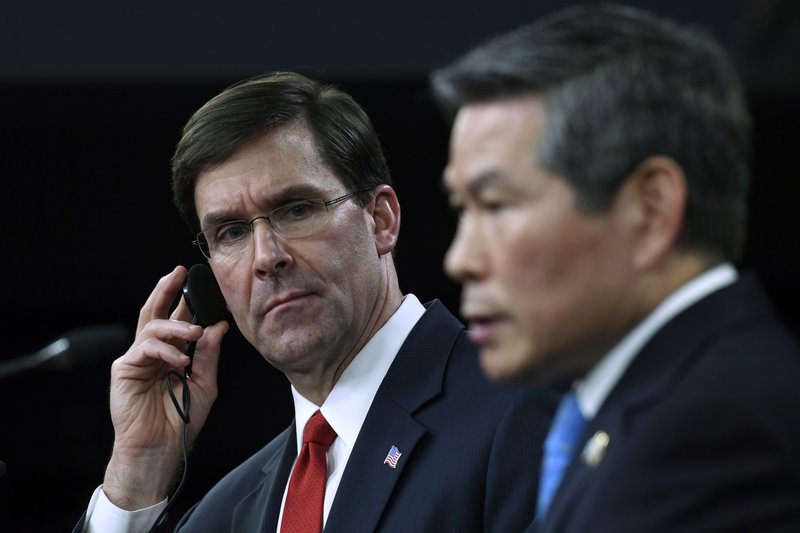The United States and South Korea are considering curtailing joint military exercises due to concerns about the spread of coronavirus, officials said Monday.
After a meeting at the Pentagon to review a full range of issues, including a standoff over U.S. demands that Seoul pay a much bigger share of the cost of hosting American forces, Defense Secretary Mark Esper and South Korean Defense Minister Jeong Kyeong-doo told reporters that coronavirus is a threat to their schedule of military exercises.
The exercises are held periodically throughout the year and are intended to prepare troops and commanders for potential combat against North Korea.
Esper said the top South Korean and American commanders in Seoul “are looking at scaling back” some training exercises “due to concerns about the coronavirus.” He added that he is confident that commanders will find a way to protect troops while also ensuring that both countries “remain fully ready to deal with any threats that we might face together.”
Jeong said the coronavirus situation in his country is “quite serious” and has compelled authorities to limit the movement of troops, which makes it more difficult to conduct exercises with American forces. He said there have been 13 confirmed coronavirus cases in the South Korean military.
“Because movement has been limited between units, the situation is limited,” he said through an interpreter.
News reports said that South Korea’s government banned major rallies in its capital and declared a health emergency. Officials said 100 new cases were reported Friday, bringing the country’s total to 204.
In their remarks to reporters, Esper and Jeong left no doubt that their governments are stuck in a difficult standoff over the U.S. demand for an unusually large increase in South Korea’s share of the cost of maintaining U.S. forces on the peninsula.
Negotiations have reached a standstill. Jeong said a U.S. threat to furlough Korean workers who support U.S. forces is “a very difficult pill to swallow.”
Over the years, the amount that Seoul pays for the presence of about 28,000 U.S. troops has varied, and most recently it was almost $1 billion. But the latest agreement between the two countries expired at the end of last year, and a new pact has not been approved.
According to the Pentagon, the U.S. has so far been paying the salary costs of the Korean National workforce. But the U.S. funds will run out at the end of March unless the Korean government agrees to pay much more. If no agreement is reached, Esper said, the U.S. will furlough most Korean employees on April 1 and would also suspend some construction and other activities.
News reports have said the Trump administration is demanding a five-fold increase in South Korean contributions, to about $4.7 billion for 2020, but officials have not publicly confirmed the specifics.
Esper said that South Korea is a “global economic powerhouse” and should contribute more to the cost of having American forces on the peninsula. Jeong said that South Korea increased its contribution by 8.2 percent last year and is considering a higher increase this year.
The so-called Special Measures Agreement helps to offset the significant cost of stationing U.S. forces., which have operated there since the Korean War, which lasted from 1950 to 1953. Contributions are divided across three categories: Korean National labor, South Korean-funded construction, and logistics, with the vast majority of South Korean contributions going back into its economy.
(AP)











